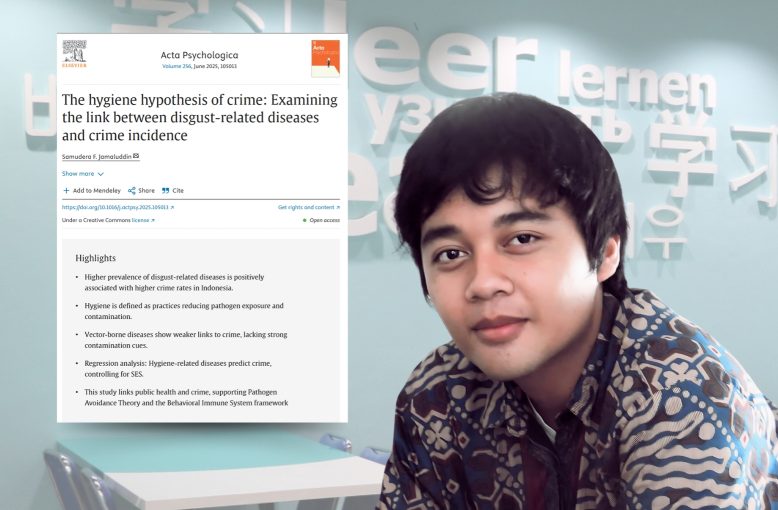
Yogyakarta, April 23, 2025 — An article titled “The Hygiene Hypothesis of Crime: Examining the Link Between Disgust-Related Diseases and Crime Incidence” by Samudera F. Jamaluddin has been published in Acta Psychologica, Volume 256, article number 105013. This journal is indexed in Scopus with a Best Quartile (Q1), an SJR score of 0.854 (2024), and an Impact Factor (IF) of 2.1.
According to Samudera, the article proposes a novel approach to understanding the relationship between disease and criminal behavior through the lens of the hygiene hypothesis and pathogen avoidance theory. By combining data on diseases associated with disgust and crime rates, the author found a significant correlation in specific regions.
“This research highlights how the incidence of certain infectious diseases may be related to crime rates. This pattern persists even after accounting for various factors such as social inequality, unemployment rates, the Human Development Index, and other socioeconomic indicators. These findings offer important implications for the fields of public health, criminology, and evolutionary psychology,” said Samudera.
The relevance of this article to the Sustainable Development Goals (SDGs) is reflected in its contributions to SDG 3 (Good Health and Well-being), SDG 10 (Reduced Inequalities), and SDG 16 (Peace, Justice, and Strong Institutions), particularly in terms of understanding the psychosocial factors that influence social stability.
Below is the abstract, keywords, and article link:
Abstract. Disgust, an evolutionarily adaptive mechanism for pathogen avoidance, plays a critical role in shaping social and moral behaviors. However, its influence on societal outcomes, such as crime, remains underexplored. This study examines the relationship between disgust-related diseases (diarrhea, HIV, and leprosy) and violent crimes (sex-related crimes, assault, and homicide) in Indonesia, a high-pathogen-stress environment. Using publicly available data from 2022 to 2023, we analyzed correlations between disease prevalence and crime incidents, controlling for socioeconomic factors, including population density, the Gini coefficient, the unemployment rate, the Human Development Index (HDI), and a refined divorce ratio in 34 provinces in Indonesia. The findings reveal that disgust-related diseases are consistently associated with elevated crime incidents, even after adjusting for socioeconomic controls. In contrast, vector-related diseases (e.g., malaria, dengue, and filariasis) demonstrate weaker and less consistent associations. Composite measures further indicate that disgust-related diseases are strong predictors of overall crime index. The overall model explains 68.5% of its variance. These results support the hypothesis that pathogen-related disgust mechanisms uniquely contribute to societal dynamics, extending pathogen avoidance theory to the realm of criminology. This research underscores the intersection of public health and societal stability, highlighting the need for interdisciplinary strategies to address disgust-related diseases and their broader social implications.
Keywords: Pathogen avoidance theory; Crimes; Disgust-related diseases; Vector-related diseases
This publication is accessible at: https://www.sciencedirect.com/science/article/pii/S0001691825003269
Based on the keywords, this article is a research output aligned with SDG 3, 10, and 16.
Congratulations to Mr. Samudera.
Writer & Editor: UP & Public Relations Team
